

Gray's biopsychological theory of personality. The biopsychological theory of personality is a model of the general biological processes relevant for human psychology, behavior, and personality.
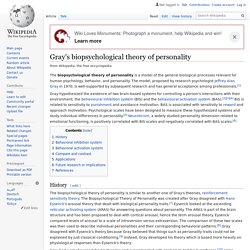
The model, proposed by research psychologist Jeffrey Alan Gray in 1970, is well-supported by subsequent research and has general acceptance among professionals.[1] Gray hypothesized the existence of two brain-based systems for controlling a person's interactions with their environment: the behavioural inhibition system (BIS) and the behavioural activation system (BAS).[2][3][4] BIS is related to sensitivity to punishment and avoidance motivation.
BAS is associated with sensitivity to reward and approach motivation. Sensory processing sensitivity. Characteristics of SPS as graphically summarized by Greven et al.
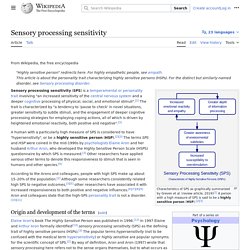
(review article, 2019)[1] A person with a high measure of SPS is said to be a highly sensitive person (HSP).[2][3] Sensory processing sensitivity (SPS) is a temperamental or personality trait involving "an increased sensitivity of the central nervous system and a deeper cognitive processing of physical, social and emotional stimuli".[2] The trait is characterized by "a tendency to 'pause to check' in novel situations, greater sensitivity to subtle stimuli, and the engagement of deeper cognitive processing strategies for employing coping actions, all of which is driven by heightened emotional reactivity, both positive and negative".[3] Origin and development of the terms[edit] In 2015, sociologist Elizabeth Bernstein wrote in The Wall Street Journal that HSPs were "having a moment," noting that several hundred research studies had been conducted on topics related to HSPs' high sensitivity.
Alexander Shulgin. Alexander "Sasha" Theodore Shulgin[2] (born June 17, 1925) is an American medicinal chemist, biochemist, pharmacologist, psychopharmacologist, and author.
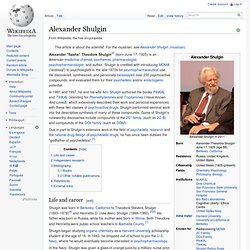
Shulgin is credited with introducing MDMA ("ecstasy") to psychologists in the late 1970s for psychopharmaceutical use. He discovered, synthesized, and personally bioassayed over 230 psychoactive compounds, and evaluated them for their psychedelic and/or entactogenic potential. Due in part to Shulgin's extensive work in the field of psychedelic research and the rational drug design of psychedelic drugs, he has since been dubbed the "godfather of psychedelics".[3] Vittorio Gallese. Vittorio Gallese is professor of Psychobiology at the University of Parma, Italy, and was professor in Experimental Aesthetics at the University of London, UK (2016-2018).

He is an expert in neurophysiology, cognitive neuroscience, social neuroscience, and philosophy of mind. Gallese is one of the discoverers of mirror neurons. His research attempts to elucidate the functional organization of brain mechanisms underlying social cognition, including action understanding, empathy, language, mindreading and aesthetic experience. Background[edit] Norman Geschwind. Norman Geschwind (January 8, 1926 – November 4, 1984) was a pioneering American behavioral neurologist, best known for his exploration of behavioral neurology through disconnection models based on lesion analysis.
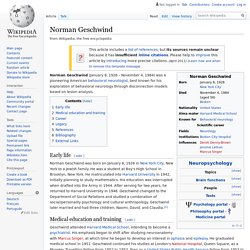
Early life[edit] Norman Geschwind was born on January 8, 1926 in New York City, New York to a Jewish family. He was a student at Boy's High School in Brooklyn, New York. He matriculated into Harvard University in 1942, initially planning to study mathematics. His education was interrupted when drafted into the Army in 1944. Mentalization. In psychology, mentalization is the ability to understand the mental state, of oneself or others, that underlies overt behaviour.[1] Mentalization can be seen as a form of imaginative mental activity that lets us perceive and interpret human behaviour in terms of intentional mental states (e.g., needs, desires, feelings, beliefs, goals, purposes, and reasons).[2][3] It is sometimes described as "understanding misunderstanding.
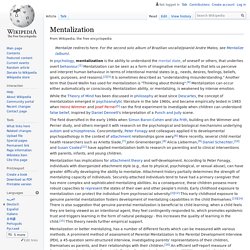
" Another term that David Wallin has used for mentalization is "Thinking about thinking".[4] Mentalization can occur either automatically or consciously. Mentalization ability, or mentalizing, is weakened by intense emotion. The field diversified in the early 1990s when Simon Baron-Cohen and Uta Frith, building on the Wimmer and Perner study, and others merged it with research on the psychological and biological mechanisms underlying autism and schizophrenia.
See also[edit] References[edit] ^ Anthony Bateman; Peter Fonagy (2006). Savant syndrome. Savant syndrome is a condition in which someone with significant mental disabilities demonstrates certain abilities far in excess of average.[1][2] The skills at which savants excel are generally related to memory.[1] This may include rapid calculation, artistic ability, map making, or musical ability.[1] Usually just one special skill is present.[1] Those with the condition generally have a neurodevelopmental disorder such as autism spectrum disorder or have a brain injury.[1] About half of the cases are associated with autism and may be known as "autistic savants".[1] While the condition usually becomes apparent in childhood, some cases may develop later in life.[1] It is not recognized as a mental disorder within the DSM-5.[5]

Brain works like a radio receiver. Marvin Minsky. Marvin Lee Minsky (August 9, 1927 – January 24, 2016) was an American cognitive scientist concerned largely with research of artificial intelligence (AI), co-founder of the Massachusetts Institute of Technology's AI laboratory, and author of several texts concerning AI and philosophy.[12][13][14][15] Biography[edit] Marvin Lee Minsky was born in New York City, to an eye surgeon father, Henry, and to a mother, Fannie, who was an activist of Zionist affairs.[15][16] His family was Jewish.
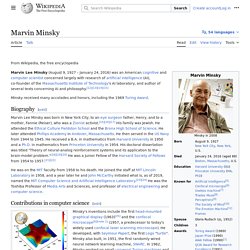
He attended the Ethical Culture Fieldston School and the Bronx High School of Science. He later attended Phillips Academy in Andover, Massachusetts. He then served in the US Navy from 1944 to 1945. High Dopamine States and Patternicity. Scientists improve people's creativity through electrical brain stimulation. Scientists have found a way to improve creativity through brain stimulation, according to researchers at Queen Mary University of London (QMUL) and Goldsmiths University of London.

They achieved this by temporarily suppressing a key part of the frontal brain called the left dorsolateral prefrontal cortex (DLPFC), which is involved in most of our thinking and reasoning. The results, published in the journal Scientific Reports, show that participants who received the intervention showed an enhanced ability to 'think outside the box'. "We solve problems by applying rules we learn from experience, and the DLPFC plays a key role in automating this process," commented Dr Caroline Di Bernardi Luft, first author from QMUL's School of Biological and Chemical Sciences who conducted the research while previously working at Goldsmiths University of London, with Dr Michael Banissy and Professor Joydeep Bhattacharya.
Transcranial magnetic stimulation. Transcranial magnetic stimulation (TMS) is a form of neurostimulation.

TMS is a non-invasive procedure in which a changing magnetic field is used to cause electric current to flow in a small targeted region of the brain via electromagnetic induction. Transcranial magnetic stimulation. Oliver Wendell Holmes Sr. Oliver Wendell Holmes Sr. (/hoʊmz/; August 29, 1809 – October 7, 1894) was an American physician, poet, and polymath based in Boston. A member of the Fireside Poets, he was acclaimed by his peers as one of the best writers of the day. His most famous prose works are the "Breakfast-Table" series, which began with The Autocrat of the Breakfast-Table (1858). He was also an important medical reformer. Ideasthesia. Method of loci. The method of loci (loci being Latin for "places") is a method of memory enhancement which uses visualizations with the use of spatial memory, familiar information about one's environment, to quickly and efficiently recall information.
The method of loci is also known as the memory journey, memory palace, or mind palace technique. This method is a mnemonic device adopted in ancient Roman and Greek rhetorical treatises (in the anonymous Rhetorica ad Herennium, Cicero's De Oratore, and Quintilian's Institutio Oratoria). Many memory contest champions claim to use this technique to recall faces, digits, and lists of words. These champions' successes have little to do with brain structure or intelligence, but more to do with using spatial memory[1] and the use of the method of loci. 'the method of loci', an imaginal technique known to the ancient Greeks and Romans and described by Yates (1966) in her book The Art of Memory as well as by Luria (1969).
Clavier à lumières. The clavier à lumières ("keyboard with lights"), or tastiera per luce, as it appears in the score, was a musical instrument invented by Alexander Scriabin for use in his work Prometheus: Poem of Fire. However, only one version of this instrument was constructed, for the performance of Prometheus: Poem of Fire in New York City in 1915.[1] The instrument was supposed to be a keyboard, with notes corresponding to colors as given by Scriabin's synesthetic system, specified in the score,[2] However, numerous synesthesia researchers have cast doubt on the claim that Scriabin was a synesthete.[3][4][5][6] The "Luce" part is notated on a treble staff with two parts, one proceeding on the circle of fifths during the piece, the other following the tonal centre of the music.
Solomon Shereshevsky. Solomon Veniaminovich Shereshevsky (Russian: Соломон Вениаминович Шерешевский; 1886 – 1 May 1958), also known simply as 'Ш' ('Sh'), 'S.', or Luria's S was a Russian journalist and mnemonist active in the 1920s. He was the subject of Alexander Luria's The Mind of a Mnemonist (1968). Scriabin and his "Prometheus" Alexander Luria. Alexander Romanovich Luria (Russian: Алекса́ндр Рома́нович Лу́рия, IPA: [ˈlurʲɪjə]; 16 July 1902 – 14 August 1977) was a notable neuropsychologist, often credited as a father of modern neuropsychological assessment.
Phenelzine. Indications[edit] Phenelzine is used primarily in the treatment of major depressive disorder (MDD). Patients with depressive symptomology characterized as "atypical", "nonendogenous", and/or "neurotic" respond particularly well to phenelzine.[1] The medication is also useful in patients who do not respond favorably to first and second-line treatments for depression, or are "treatment-resistant".[2] In addition to being a recognized treatment for major depressive disorder, phenelzine is effective in treating dysthymia,[3] bipolar depression (BD),[4] panic disorder (PD),[5] social anxiety disorder,[6] bulimia,[7] and post-traumatic stress disorder (PTSD).[8]
Phenelzine. Clinical Global Impression. The Clinical Global Impression (CGI) rating scales are measures of symptom severity, treatment response and the efficacy of treatments in treatment studies of patients with mental disorders.[1] Many researchers,[who?] While recognizing the validity of the scale, consider it to be subjective as it requires the user of the scale to compare the subjects to typical patients in the clinician experience. Tryptophan AND 5-HTP, a Comparison. L-Tryptophan. DanceSafe. DanceSafe. DanceSafe is a nonprofit organization, with 21[1] local chapters in the US and Canada. DanceSafe youth volunteers set up tables at raves and other events to distribute non-biased educational literature containing information describing the effects and risks associated with the use of various drugs and sell testing kits so that users may obtain more information about the contents of their pills[2].
5-Hydroxytryptophan. Uses[edit] Tryptophan. Circadian Rhythm Abnormalities. How BrainPort Works. Neuroplasticity. Sensory substitution. Paul Bach-y-Rita. David Marr (neuroscientist) Category:Attention deficit hyperactivity disorder researchers. Methylphenidate. Dopamine agonist. James Gross. Kenneth A. Dodge. Crossover study - Wikipedia. Cannabis, the Holy Grail, and the Secrets of the Templars? FANDOM powered by Wikia. Timothy Leary - Wikipedia. Timothy Leary - Wikipedia.